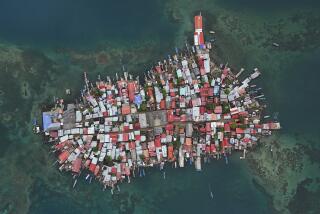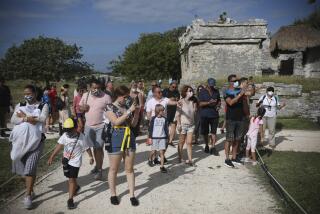Last Chance for Eden
BOCAS DEL TORO, Panama — I have plenty to tell you about these islands at the Caribbean side of Panama, mostly concerning the empty beaches, jungle critters, tropical fish and quirky little lodgings and restaurants. But most of this, I suspect, will fade like so much Muzak behind the five words that are coming right up.
These words fell from the mouth of Jeff Condit, 26, formerly of San Francisco, as he lounged at the Barco Hundido, an open-air waterfront bar in downtown Bocas del Toro. It was my second night in town on a visit late last year. Tall palms rustled, and the moon hung above us like a street lamp. Just beyond the rough planks of the floor, I could make out the rusted hulk of a submerged shipwreck, perhaps 100 feet long, spotlighted in the shallow water. Hence the bar’s nickname, the Wreck Deck, where beers go for 50 cents during happy hour.
Already I had seen the archipelago’s excellent snorkeling, learned of the remarkable diving and respectable surfing, held a tiny red poison dart frog (whose secretions can cause problems if you have a cut in your skin) and looked at several lodgings for $40 or less. I had even glimpsed Zapatilla Minor, a thickly vegetated cay not quite big enough to be called an island, which was being used as a stage set for an Italian knockoff of the “Survivor” series.
Condit (no relation to the congressman) had the lazy manner of somebody who had been hanging out in Bocas for quite a while. Exactly what, I asked, have you been doing here?
“We play bocce with coconuts,” he said.
Those are the words, and they explain much about Bocas.
“The hardest part is figuring out which coconut is yours,” he continued. “But after a couple of hours, you get it. And then it’s all good.”
It certainly sounded good. And the closer I looked, the more intriguing I found Bocas del Toro, a spot that has become a magnet for the young, hip backpacker crowd--for now.
The archipelago, which includes more than 60 islands, lies just south of the Costa Rican border, between mainland Panama and the Caribbean Sea. The town of Bocas del Toro, nerve center of the region despite its modest population of around 1,200, is on Isla Colon, the largest of the islands, which lies about 25 miles south of Costa Rica. Next to Colon lies Isla Bastimentos, part residential, mostly national park.
These islands are a young, rustic, cheap, quaint, lazy territory, where day follows day of snorkeling, sipping beer at water’s edge or probing the greenery on Bastimentos, a 10-to 30-minute boat ride from Bocas town. There are no luxury resorts or Senor Frog’s. And you won’t find what you’ll find in most of the rest of the Caribbean: high prices for lodging or food that the rest of the world, lured by its sea and sand, seems willing to pay.
Foreigners--including many Americans and Italians--have been quietly buying up property since about 1994, and the place seems ripe for additions that will strain the environment and subtract charm but add jobs and revenue.
The area is often rainy, especially May through August and November through December, but the showers frequently fall overnight and clear by daybreak. The average temperature is 82. The peak months for tourist arrivals, hoteliers say, are March and September.
I wouldn’t necessarily build a trip around these islands alone. But in combination with other outdoorsy adventures in Panama near the canal or Panama City, and in light of Sept. 11 and the need to feel isolated, at times, from the world, these islands are well worth contemplating. My flight from Panama City took about an hour, cost about $100 round trip, and yielded striking views, first of the Panama Canal and the country’s central jungle, then of the coastline.
In Bocas town there are no hotels with more than 35 rooms, no buildings with more than two stories, and probably fewer than 100 automobiles. Many of the locals trace their roots to Africa, not Spain. Along with Spanish and English, visitors hear a unique local pidgin, a little Spanish, a little English, a little of the Guaymi Indian language that predates Columbus, all with a Caribbean lilt. Locals say the town has about 300 beds for visitors, but that number is growing..
Locals often travel in canoes carved from a single tree trunk. Most tourists make their rounds in water taxis or on rented bicycles. In fact, if you plan on making a lot of rounds, Bocas may not be your ideal destination. Not a lot happens, and a visitor needs to make peace with that.
Here’s what I did:
* Patrolled Calle 3, the funky main drag. I counted one bank, three dive shops and half a dozen tour companies, most of which offer day trips to nearby islands or Indian villages. In stores and eateries, credit card acceptance is spotty, and newcomers are advised not to drink the tap water. There are no surf shops, although ridable waves can be found in a few spots around the island.
Many of the town’s most historic buildings, including an 1897 cathedral, have been lost over the years to fires, tornadoes and earthquakes. Much of the growth in recent years, it seems, has come from Italian entrepreneurs, who own the Swan’s Key Hotel (fanciest in town at $70 nightly and up, but, in my experience, not the friendliest) and the Hotel Laguna (more affordable and approachable). The Bocas del Toro Hotel, an 11-room lodging with Spanish management and rates around $55 nightly, opened in September.
Down in the little city park, a merchant strings up colorful applique fabric molas made by Panama’s Kuna Indians. (Most of the Kuna live in the San Blas Islands, more than 200 miles west of the Bocas del Toro archipelago.)
* Walked trails and combed beaches on and around Bastimentos Island. Bastimentos Island Marine National Park, set aside in the 1980s, is home to sloths, howler monkeys, toucans, parrots, iguanas, four species of sea turtle, 200 kinds of tropical fish and a rare species of tiny red frog, known as the poison dart frog. On a day trip arranged through Ancon Expeditions (one of several companies offering tour packages), a guide led me to a jungle clearing crawling with the frogs. Nearby, off the protected (and otherwise empty) cay of Zapatilla Major, I pulled on snorkel and mask to commune with big blue fish, little yellow fish and medium-sized blue-and-yellow fish. (On the way to my destination, my guide, Tapio, stopped to buy 11 live lobsters from a Guaymi Indian who was heading back to town in his canoe. The price: $5.)
* Soaked up small-town atmosphere on the residential end of Bastimentos, which has a population of about 550.
The main drag is a 7-foot-wide cement walking strip. No cars, and not many bicycles. Though the community is mostly made up of wood houses painted bright Caribbean hues, there is a handful of businesses, including Pension Tio Tom Bastimentos, a restaurant and lodging opened by German emigres Tom and Ina Reichelt five years ago. The bright yellow pension stands above the water on stilts, rates run $10 to $20 nightly, and the showers and toilets drain unfiltered into the sea. (Local government hasn’t gotten around to installing a modern sewage system, Tom Reichelt said. He added that fishing and swimming is forbidden around the pension, but “last time we counted, we had 38 species of fish underneath.”) At the pricier end of the spectrum on Bastimentos is the Al Natural Resort. I didn’t get a chance to see it, but in the new edition of the Lonely Planet guidebook, author Scott Doggett labels it his favorite place in Panama. (Its rates are typical of several rustic but all-inclusive resorts in the area: $55 to $75 per person per day, all meals and kayak and snorkel rentals included. More information is available at https://www.bocas.com.)
* Ate and drank. This trip was not a culinary triumph: I got an upset stomach after breakfast at the clamorous Don Chicho, a favored spot on the main drag for morning coffee. Among repeat visitors, the restaurants El Ultimo Refugio (on Avenida Sur) and El Pecado (on Calle 3) get high marks. I did like the fish and the waterfront, alfresco atmosphere at the Reef restaurant. And I had a fine time sampling Balboa beer while questioning fellow patrons at the Wreck Deck. As the hour grew late, some of these patrons, male and female, elected to stripstrip to their underwear and leap into the sea, an activity on which I passed.
Another thing I didn’t do, only because of my own bad timing, was eat lunch at El Paso de Marisco. This is a restaurant on stilts at Coral Cay, also known as Crawl Cay. Lunches of fish or lobster range from $7 to $14, and dining areas are five thatched huts on the water. You order your fresh fish as your boat passes by in the morning, then snorkel or explore for a few hours and return for lunch.
It’s easy enough to see evidence of Bocas town’s earlier history. In 1899, when a fledgling banana company called United Fruit was adding plantations in the area, its officers put an office in Bocas town, and the ensuing business boom pushed the population to 25,000.
The office was moved and the population dipped after a blight in the 1920s, but the company grew into one of the most powerful forces in the shaping of 20th century Latin America, buying property, running plantations, bribing the occasional dictator, controlling government rail and mail concessions in various countries, reaping enormous profits and provoking revolutionaries for decades before its fortunes waned in the 1960s and later.
Now known as Chiquita Brands International and operating with a much lower profile, the company continues to grow bananas on neighboring islands. But two reminders of earlier days have prominent spots along Bocas del Toro’s main drag.
One is the old dock, where bananas were loaded. It has been converted into the Reef restaurant, which is partly owned by fruit company employees who work on neighboring islands.
The other vestige of United Fruit’s first foothold is the old company safe. Workers apparently decided it was too heavy to move, so they left it behind in the building that houses the Bahia Hotel on Calle 3. Hotel rates range from $22 (for a room awaiting renovation) to $40 (for one already renovated). In the lobby stands the old safe, bigger than a breadbox and incalculably more secure, now reduced to protecting Styrofoam cups and replacement ceiling tiles.
I paid about $50 nightly for a plain, windowless, air-conditioned room at the five-room Bocas Inn, but realized I could have paid less for the same amenities or paid the same for more. (Otherwise I have only praise for the Bocas Inn’s parent company, Ancon Expeditions, which arranged my itinerary inside Panama.) Next time, I would be tempted by either one of the $40 rooms at the Hotel Bahia or one of the $45 rooms at Cocomo on the Sea, a tidy, waterfront, four-room inn that includes breakfast with your room rate. Both looked clean and inviting when I inspected them.
Isla Colon measures about eight by 20 miles. Its neighbor Bastimentos is a bit smaller. Check the https://bocasdeltoro.net Web site and you will find hints of the place’s potential, and its potential ruin. The real estate offers in late October include a lot in Bocas town for $25,000, a seven-acre beachfront site for $145,000, 50 acres of beachfront jungle on Isla Bastimentos for $126,500. Also, added the shoppers’ guidelines from Island Realty, “there are currently no zoning laws or building restrictions in the islands.” Even if that’s an oversimplification (as the guidelines note elsewhere, environmental impact studies may be required), it gives a flavor of the wide-open way of things here.
“We’ve been here 19 months. It’s getting better all the time. A new grocery just went in, and they’re working on the roads,” says Pennie Lang, who owns the Cocomo on the Sea bed-and-breakfast in Bocas town with her husband, Ed.
“Right now there are only about five roads that are actually paved,” she adds. “But they’ve got the machinery here to do more. It won’t be up to U.S. standards or anything, but ... “
But it’s progress. And if you’re the sort of traveler who would even consider these islands, this leaves you a classic developing-destination decision to make: Would you rather see Bocas del Toro before all the roads are paved, the plumbing improved and the rates raised, or after?
Guidebook: Chillin’ in Bocas
* Getting there: Bocas del Toro is most easily reached via Panama City. From LAX, nonstop service is on COPA; there is connecting service on Delta, American, Continental, Mexicana and LACSA. Restricted round-trip fares begin at $353. Daily flights from Panama City to Bocas take one hour and cost about $50 each way on Aeroperlas and Mapiex Aero airlines.
* Telephones: To reach numbers below from the U.S., dial 011 (the international access code), 507 (the country code for Panama) and the local number.
* Where to stay: Hotel Bahia, Calle 3; 757-9626, fax 757-9692, https://www.panamainfo.com/hotelbahia. It has 20 rooms (16 with air-conditioning); about half have been renovated. Rates: $27.50-$38.50 double.
Cocomo on the Sea, Avenida Norte and Calle 6; tel./fax 757-9259, https://www.panamainfo.com/cocomo. Four air-conditioned rooms at water’s edge, a short walk from the main drag. American owned. Rates: $45 per night, breakfast included, increasing to $52 on Jan. 1.
For unfussy backpackers, Pension Tio Tom Bastimentos, Isla Bastimentos; tel./fax 757-9831, e-mail [email protected], is a rustic water’s-edge hostelry on stilts. (Nature tours are offered.) The pension has four rooms, one with private bath, at $10-$20 nightly. A restaurant sells breakfast, lunch and dinner separately.
For information on restaurants and other questions, check https://www.panamainfo.com, https://www.bocasdeltoro.com and https://www.panamatours.com/default.htm.
* For more information: The Consulate General of Panama, 3137 W. Ball Road, Suite 104, Anaheim, CA 92804; (714) 816-1809. Also, Lonely Planet just published the second edition of its Panama guidebook, which includes 26 pages on Bocas.
More to Read
Sign up for The Wild
We’ll help you find the best places to hike, bike and run, as well as the perfect silent spots for meditation and yoga.
You may occasionally receive promotional content from the Los Angeles Times.







